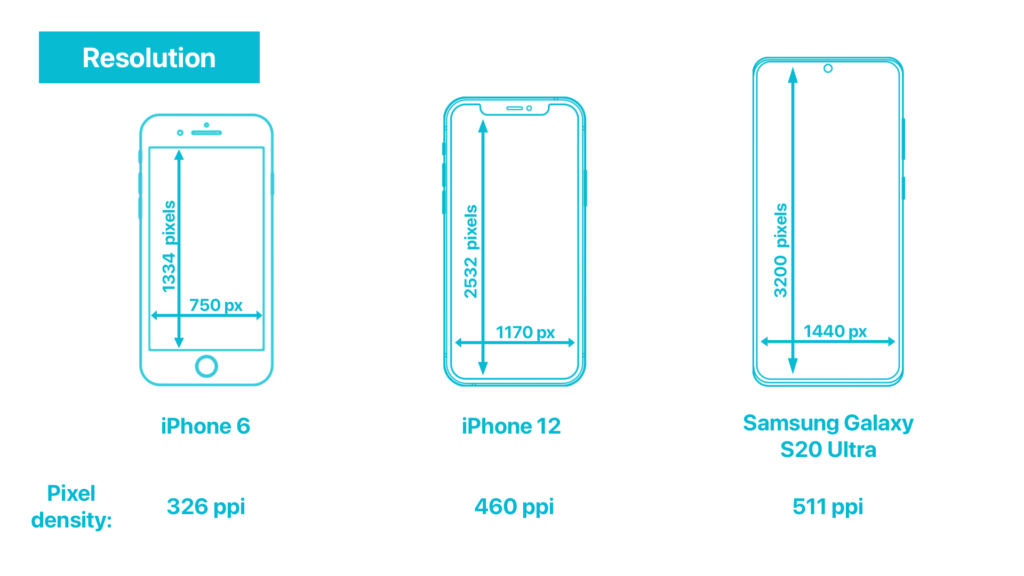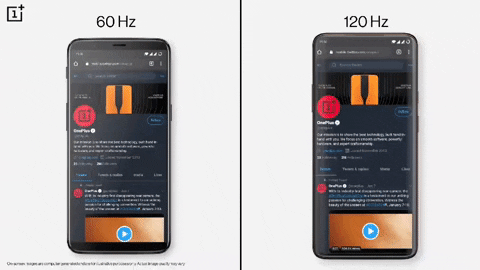Smartphone specs explained: Display
One of the most important parts of the smartphone is the display. You look at it all the time, so it better be good. There are many specs to consider when thinking about display so I will explain them in more detail to you.
There will be more articles coming from this series, focused on various smartphone specifications which are good to consider when buying a new phone. But now let’s talk about displays.
Physical display size
The first thing about the display you notice on a smartphone is its size. Today the bezels around the screen are so small, that the whole front of the device is mostly a screen. Display size is described by the length of its diagonal and is usually measured in inches.
While in the past phones were smaller, now it looks like they keep growing year over year. One might argue that smartphones are too big now. The original iPhone from 2007 had a 3.5” screen. Today, the iPhone 12 has a 6.1” screen and on the iPhone 12 Pro Max we can find an even bigger – 6.7” screen. It’s similar in the Android world. It’s almost impossible to find a smartphone with a screen under 6-inches. Only the iPhone 12 Mini and Google Pixel 4A come to my mind. Funny thing is that only a few years ago 5” handsets were considered big.

When talking about display size, you might also hear the term aspect ratio, which is the ratio of its height to its width. In the past, the standard was 16:9, but four years ago 18:9 started to get popular and now most smartphones are using that ratio or higher. You can also find phones with a 19:9 or even 21:9 aspect ratio. The higher ratios allowed manufacturers to increase the screen without increasing the width of the devices, so you can control them with one hand more easily.
Display type
In today’s smartphones, two types of displays are mostly used: LCD and OLED. Both of them can be divided into other types like TFT-LCD or IPS-LCD and Amoled or Super Amoled. But let’s focus just on the main types. LCD and OLED are two different technologies. LCDs consist of liquid crystals that don’t emit light themselves and rely on back-light instead, which illuminates the display. OLED’s pixels on the other hand can produce their own light.
Thanks to that OLED provides more contrast and deeper blacks because it can simply turn off the pixels that are supposed to be black. OLED can also provide more vivid, beautiful colors. In general OLED displays in smartphones are considered superior to LCD, but they are also more expensive. Because of that, you’ll find OLED displays usually in higher-end, more expensive smartphones.
But that doesn’t mean LCD displays are bad. The best LCDs have accurate color reproduction and can be bright and easily readable outside.
Resolution
One of the most important parts of a smartphone’s display is resolution. Screen resolution refers to the clarity of the text and images that are displayed on your screen. Resolution is usually measured in pixels and the more is the better. The screen resolution basically means how many pixels can be displayed horizontally and vertically. One of the popular resolutions is Full HD which is 1920 x 1080 pixels.
For example, Samsung Galaxy S21 has a screen resolution of 2400 x 1080 pixels and iPhone 12 has a resolution of 2532 x 1170 pixels. As I said, the more, the better. But the resolution itself doesn’t tell the whole story. It makes a difference to have a 1920 x 1080 resolution on a 5-inch phone and on a 6,7” phone. The same resolution will look better on a smaller screen because to fit the same number of pixels on the smaller area means that pixels need to be smaller, so everything looks sharper.

Apart from the resolution itself, it is also good to know the density of pixels. It is measured as pixels per inch (PPI). Apple came with the name Retina display for the screens so sharp, that humans can’t distinguish individual pixels from a regular viewing distance. For smartphones, Apple considered the threshold to be 326 PPI. Everything at this level and above should be crisp to the human eye. But today we usually see even higher pixel density for high-end smartphones. The latest iPhone 12 series have a PPI of 460, for example.
Refresh rate
The refresh rate is a parameter that only recently started to gain significance. And what does it stand for? Refresh rate simply means how many times the screen refreshes its image in one second. The higher the refresh rate is, the more fluid scrolling or playing games will feel.
Smartphones in general have been using displays with 60 Hz refresh and it started to change only three years ago. Razer Phone released in November 2017 was the first commercially available smartphone with a refresh rate higher than 60 Hz. And then competition started to adopt it as well. The Asus ROG Phone had a 90 Hz display in 2018, Pixel 4 in October 2019, and in 2020 we could find high refresh rate displays in almost any high-end smartphones. One of the exceptions is the latest iPhone which still comes with only a 60 Hz panel.
But in 2021 we will probably find 60 Hz displays only in cheaper smartphones and the rest will switch to 90 Hz, 120 Hz, or even 144 Hz. It’s hard to describe how much smoother the higher refresh rate displays are, but once you try it, you wouldn’t want to go back to a lower refresh rate.

There is also one negative aspect of a high refresh rate which is faster battery consumption. But companies already found a way to lower the impact of it. For example, Samsung Galaxy S21 Ultra has a variable refresh rate and it can automatically adjust the refresh rate between 10 Hz and 120 Hz, depending on the content you are viewing.
There is also another display parameter I didn’t mention – brightness. But most smartphones today are bright enough to use even in direct sunlight, so I don’t think there’s a need to say more about that. The rule of the thumb is that anything over 600 nits is good enough.
What’s next?
Over the years displays on smartphones got bigger, sharper, and smoother. What can we expect next? One trend could be flexible displays. Foldable phones are already here and once the technology gets cheaper and more resistant, then I think we will see it in more and more phones. Stretchable phones could also be a thing – you take a phone and stretch its display into a bigger, tablet-size screen.
We can also expect different screen types and technologies which could replace LCD or OLED. There are already new types like micro-LED or mini-LED. How many of you ever had a problem with cracked or scratched screens? One day we may get self-healing screens that repair themselves after being scratched. The polymer which can do that was discovered by a student in Japan. I would totally appreciate having a screen that can do that. The future of the smartphone’s display looks bright and I can’t wait for the next improvements.




